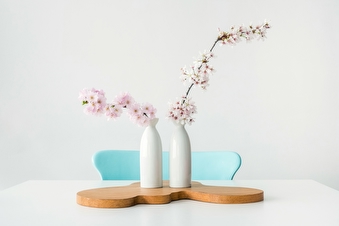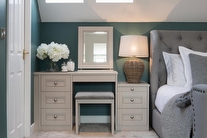
Four ways to upgrade your living room storage space
Living rooms can be hard to get right. They're often busy family rooms where children play, dogs sleep and the grown-ups take a moment with a cup of tea.

With working from home now commonplace, achieving a state of zen in your own space is more important than ever. Yet this vital need for calm has been recognised and reflected in Japanese interior design for generations.
Evoking simplicity and natural harmony, Japanese design focuses on creating a tranquil space where every element serves a purpose. By incorporating these principles in your home, you can cultivate a living environment that looks both beautiful and supports your mental and emotional well-being, making every day feel more balanced and peaceful. We explain how below.
Embracing the mantra "less is more" is fundamental to achieving a Japanese-inspired interior. Resist the urge to fill every corner with trinkets and clutter, focusing instead on those objects that mean the most to you.
The concept of ma – or a safe, tranquil space – is key in this style, allowing the eye to rest and fostering a sense of serenity. Consider investing in clever storage solutions like built-in understairs cabinets to keep everyday items organised and accessible but hidden from view. This will maintain the clean lines and uncluttered feel that is so essential in Japanese design.
The minimalist focus we've highlighted should extend to your furniture choice, with every piece serving a purpose. Opt for clean lines and low profiles to create a sense of space and calm, taking inspiration from traditional Japanese furniture pieces such as tatami mats, zabuton cushions and shoji screens.
Achieve the minimalist aesthetic in your living room with sleek sofas and armchairs set close to the ground, inviting you to relax and unwind. Coffee tables should be low and unobtrusive, perhaps crafted from rough-hewn wood or smooth stone. End tables can be replaced by slim floor lamps or strategically placed ottomans that provide additional seating and storage. The key is to create a sense of visual calm and avoid cluttering with unnecessary furniture.
Reverence for nature is traditional in Japanese culture and reflected in the country's interior design. Channel this harmony in your own home by incorporating materials like wood and stone in their raw forms, celebrating the beauty of their textures. Rough-hewn wooden beams on the ceiling can add rustic charm, while smooth stone tiles underfoot provide a sense of grounding. Glass walls or partitions, especially those opening onto a garden or courtyard, blur the lines between the inside and outside world, inviting the peacefulness of nature into your home.
Plants are a welcome addition but focus on quality over quantity. A single, well-placed bonsai tree or a gracefully cascading spider plant can add a touch of life without overwhelming the space. If you prefer flowers, opt for a simple arrangement using the principles of ikebana – the traditional Japanese art of flower arranging – with carefully selected stems, leaves, and blooms.
When it comes to colour choices in Japanese interior design, the key is to create a balanced and cohesive scheme that reflects nature's tranquillity. Light neutrals, like white or ivory on the walls, create an ideal canvas, allowing the beauty of natural materials and pops of colour to stand out.
You can introduce warmth into your space through wooden furniture and flooring or earth-tone upholstery in shades that reflect the natural world, such as mushroom, beige or light ochre. Use light and muted tones and avoid rich reds and browns that can overpower the calm atmosphere.
Similarly, add depth with touches of grey, black, deep blue or teal, but use these sparingly and strategically. A charcoal grey accent wall can create a dramatic backdrop for a curated display of ceramics, while a deep teal rug can add a touch of sophistication under a light wooden coffee table.
Decorations are placed with intent in Japanese design, with walls and other spaces often being bare except for a unique and symbolic item. From antique ceramics passed down through generations to travel mementos that evoke cherished memories, carefully chosen pieces can tell a story about your life and interests as well as being decorative.
The concept of Wabi-sabi is also central, celebrating the beauty of imperfection and impermanence. Decorative elements often have a deeper meaning, telling a story about the transient nature of the world around you. This could be a distressed wooden vase or ceramics with cracks outlined in gold plating.
Embracing Japanese interior design means crafting a home that embodies simplicity, where every element serves a purpose, and nature's beauty is seamlessly integrated into daily life. Implement the principles we've outlined, and you'll be well on your way to attaining the Japanese ideals of serenity and balance in your own living space.
Need help incorporating Japanese design principles into your home? Don't hesitate to get in touch with our team to learn more about how our storage solutions can help. Alternatively, you can book a design visit to have one of our designers visit you in person.

Living rooms can be hard to get right. They're often busy family rooms where children play, dogs sleep and the grown-ups take a moment with a cup of tea.

If you're looking for bedroom storage ideas and want to maximise your entire space, look no further.

Whether you’re looking for a place to get ready for the day or a home for your make-up and jewellery, here at Hammonds we’ve got the fitted dressing table to suit you.
Whether you have an exact vision in tow, or are just at the beginning stage of your home renovation, we have heaps of inspiration for you to get stuck into.
Find a wealth of design tips, trends and inspiration in the pages of our brochure, magazine and on our blog. Our experts are always ready to help you create dream home, pop in store or book your free design visit for experts to help on bringing your vision to life.